Cook in Rio probably won’t be at the top of your list when visiting Rio de Janeiro. Well, you might change your mind after reading this post as you get acquainted with one of the most delicious Brazilian recipes: the “moqueca baiana”.
Cook in Rio: a dive into the Brazilian culture throughout its flavors
There are many different ways of delving into the local habits and cultural traits of a place. However, cooking with natives is, certainly, one of the most delicious ones.
That’s the reason why, some years ago, Chef Simone Almeida came up with the idea of hosting people from all over the world in her kitchen.
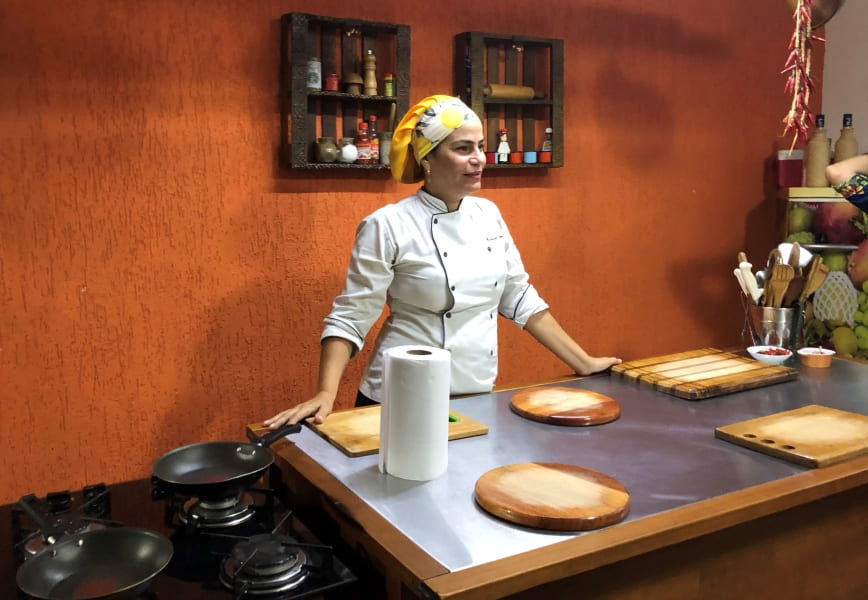
In fact, she prefers calling the place her “studio”, which pretty much makes sense, as it’s there that she shows her art to her visitors.
No matter the name you call the premises; you will certainly feel welcomed as she treats everyone as she would a dear old friend.
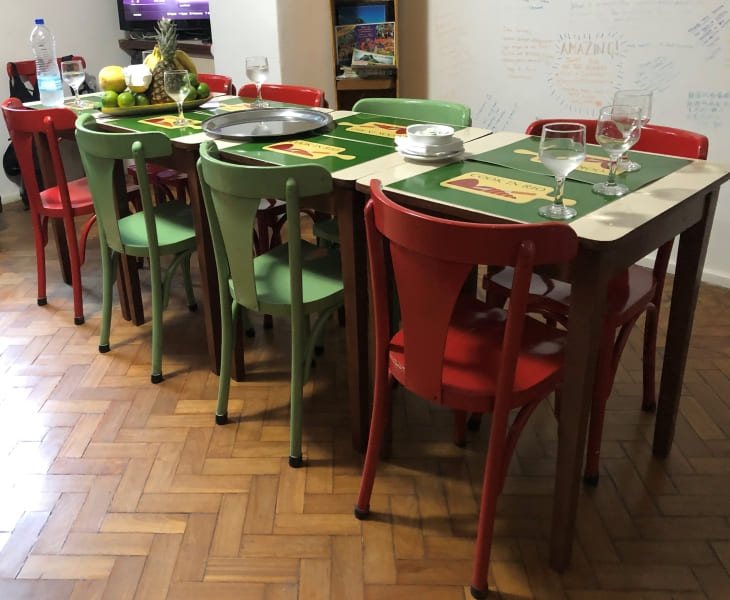
For the duration of three hours you will be introduced to multiple delicious dishes, from starters to dessert. All of it combining good sips of caipirinha with a wonderful talk.
Why moqueca baiana, if you are visiting Rio?
First things first: every state in Brazil has its own most famous dish, but moqueca is not a typical dish from Rio.
Moqueca is a salt water fish stew which is very popular in Bahia, a state in the Northeast of Brazil.
It’s also commonly appreciated in Espírito Santo, a state in the Southeast of Brazil. However, in the latter, there are some variations. The first is the name, as it is called moqueca capixaba.
The second is the fact that the baiana version includes dende oil (palm oil) whereas the capixaba version is prepared with olive oil and urucum (annatto).
Forgive me if I caused you some confusion! Cariocas are natives from Rio, as everybody knows. Hence, baianas(os) and capixabas are natives from Bahia and Espírito Santo, respectively.
Okay, but Brazil is a huge cauldron of mixtures and fusions from different backgrounds. As a consequence, the culinary influences of diverse peoples definitely spread out and some of the most iconic dishes are prepared from North to South and from East to West. Moqueca and feijoada are, definitely, two of them.
Cook in Rio: what you can expect from the experience
As soon as the class starts, you will be introduced to the other guests. Then, Chef Simone will present an overview of the major Brazilian cultural influences, obtained by the three major groups that were fundamental to form our identity: the Portuguese, the Africans and the indigenous inhabitants – who were already here before the Portuguese colonization.
After this introductory part, everybody will be invited to prepare the welcome drink. No surprises here: everybody who visits Brazil agrees that caipirinha is the most popular one.
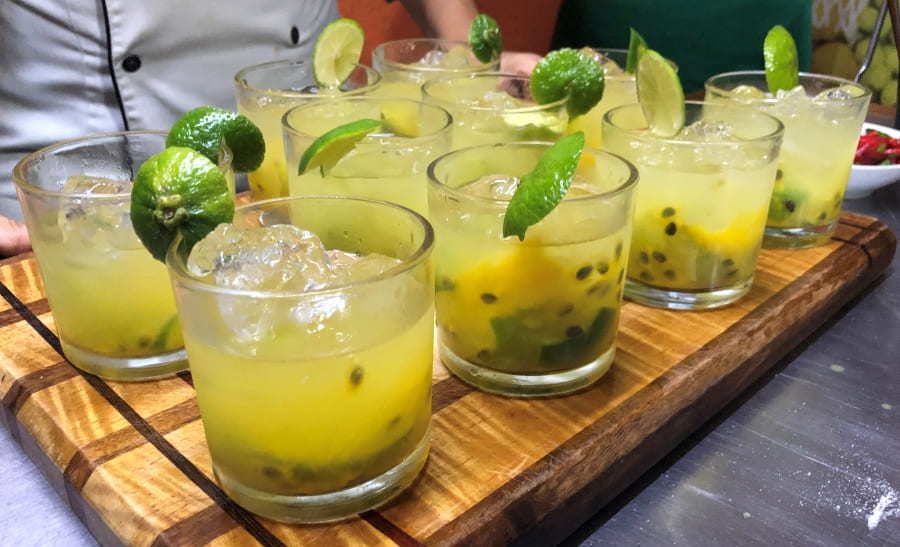
However, Chef Simone will invite everybody to make another version of caipirinha, which is called caipifruta (the combination of two different kinds of fruit). Consequently, passion fruit will be added to the regular version.
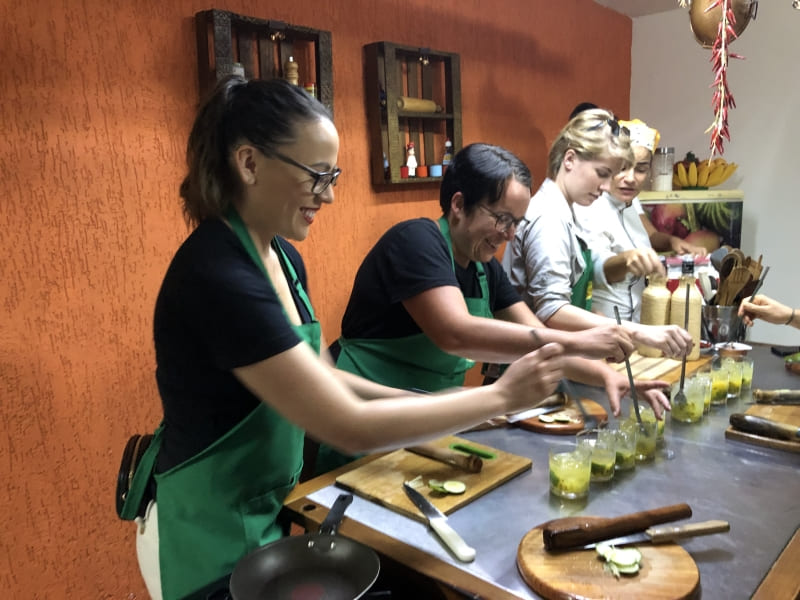
So, hands on! Everybody will have a role in this task: from cutting the lime properly to making sure that the same amount of cachaça will be poured in each glass. Cheers! Saúde! Salut! Proost! Whatever the word you pick to give a toast, it will be fun!
Once everyone is properly warmed up, it’s time to roll up the sleeves and start preparing the dishes!
The cool menu of Cook in Rio
Usually, we only have one starter in a full meal, but at Cook in Rio, there is no room for diets. That promise you always make to yourself to start your diet first thing on Monday? Forget it!
The Starters
Grilled curd cheese dice with guava sauce
First, you will taste a very famous combination of sweet and salty. A pair made of queijo coalho (curd cheese) with guava, which is called Romeo and Juliet.
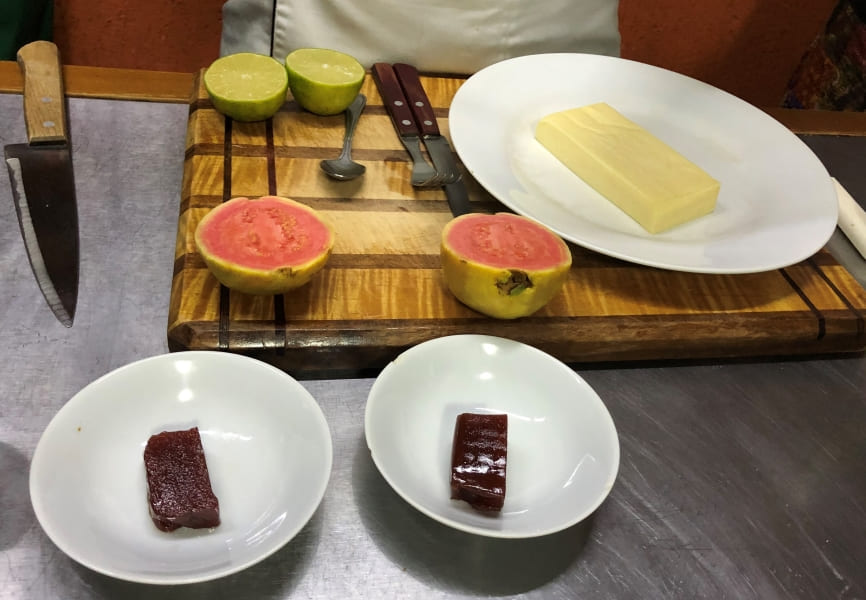
However, Chef Simone proposes a creative variation for it. Instead of only having goiabada (guava paste), this Romeo and Juliet will be prepared with grilled curd cheese dice and guava sauce made of guava paste, lime and chili pepper.
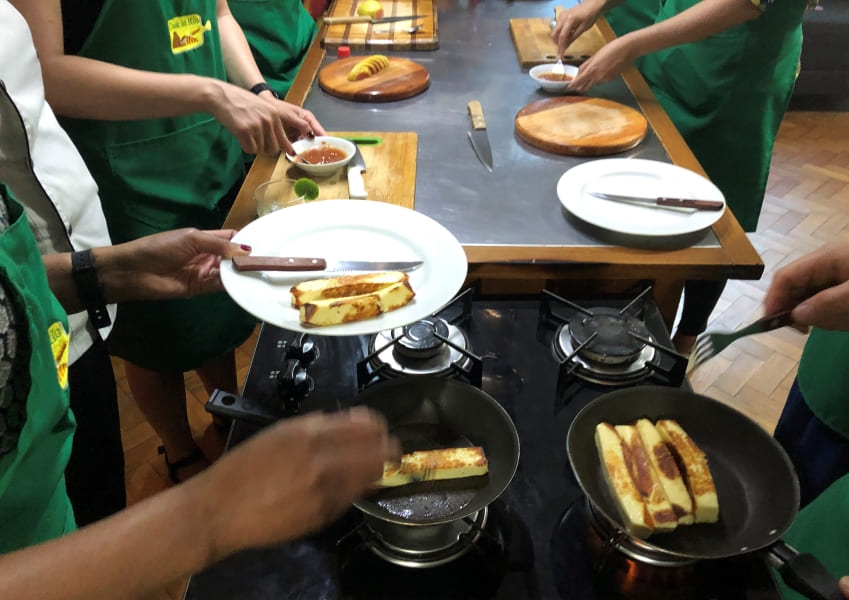
If it sounds weird to you, just try the first bite. I have to confess that I’m not a huge fan of peppers in general, but the spiciness is just perfect and the taste is incredible!
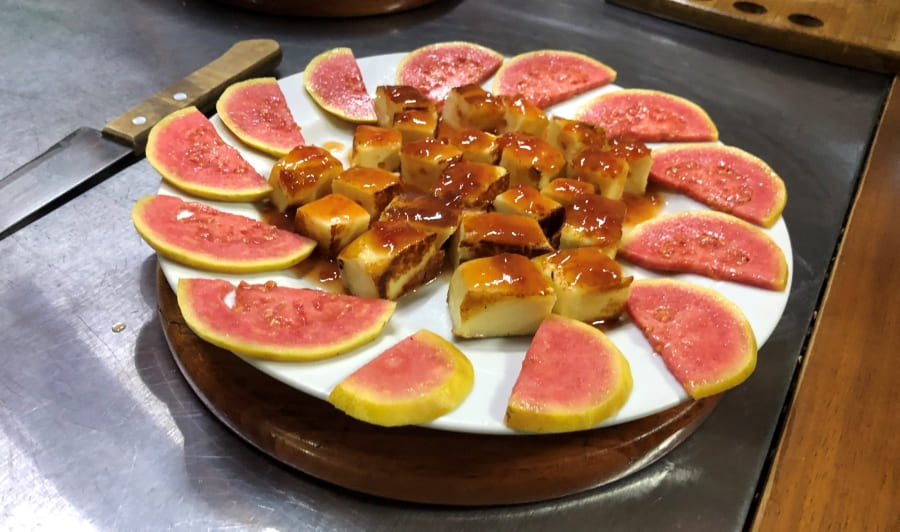
Flamed sausages with coriander pesto sauce
I must confess that although the appetizer is delicious, I don’t think I would be brave enough to make it myself at home. Simply because the thin slices of calabresa sausages are flamed in cachaça. The taste is heavenly, but putting fire in a frying pan (for me) is like hell! Hahaha…
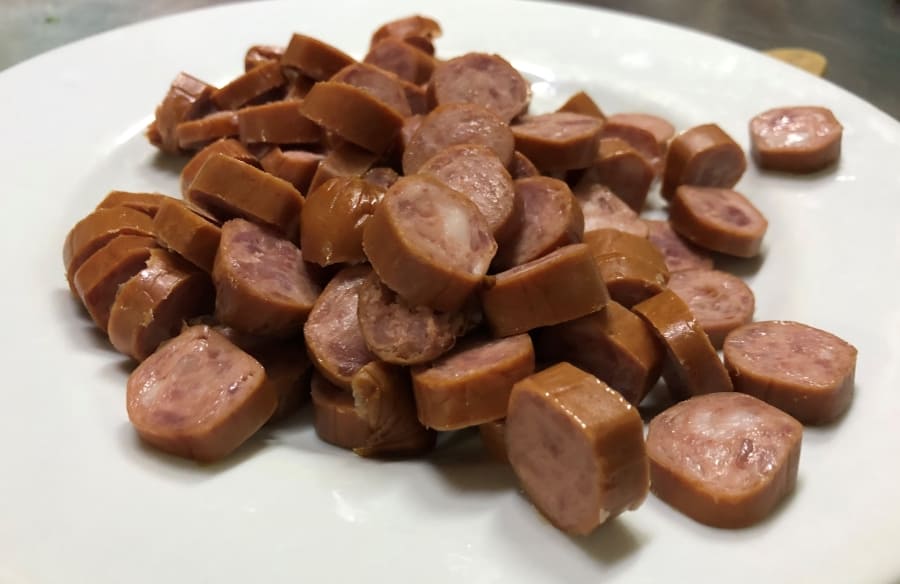
Anyway, you can try it for yourself once you take the class. My blogger friend Klécia tried with the help of the Chef Simone and survived… unburnt.
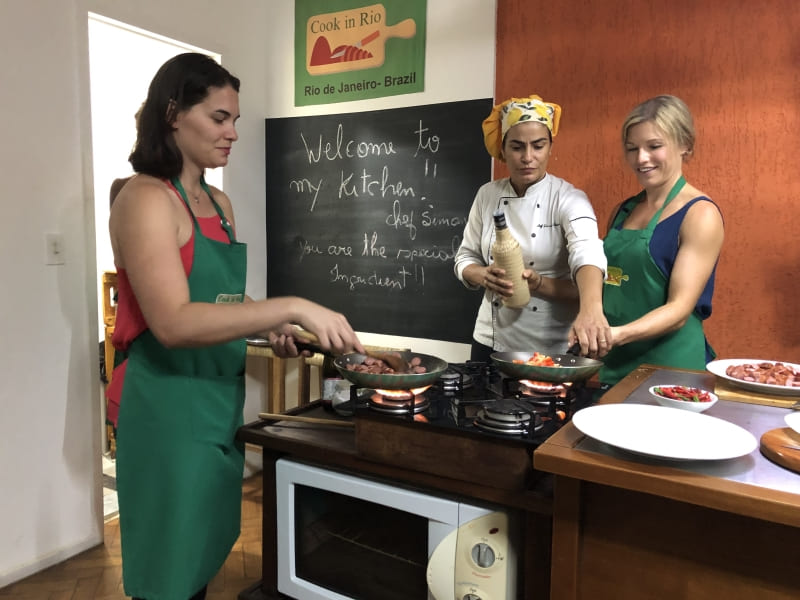
Oops… the sauce, of course: it’s a pesto made of coriander, red sweet pepper, lemon and chili pepper. All the ingredients are properly macerated and the slightly spicy pesto is done.
The side dishes
Of course, at this stage of the class, everybody is more relaxed and talkative (caipirinhas, perhaps?) and exchanging a lot of curiosities about their own cultures. It’s amazing how close people can get in the kitchen!
It’s important to point out that moqueca is never served without being accompanied by some very specific dishes: rice and plantain farofa. Thus, it’s time to start their preparation.
Preparing the rice
It may be very simple and fast to make some rice for people who cook it on a daily basis. However, there are some secrets needed to reach the perfect cooking point.
Nevertheless, for those who don’t have rice as one of the main ingredients for every single lunch or dinner, it may be a challenge to cook it to perfection. For this reason, Chef Simone explains all the tricks to the “gringos”, because with a moqueca there is no better combination.
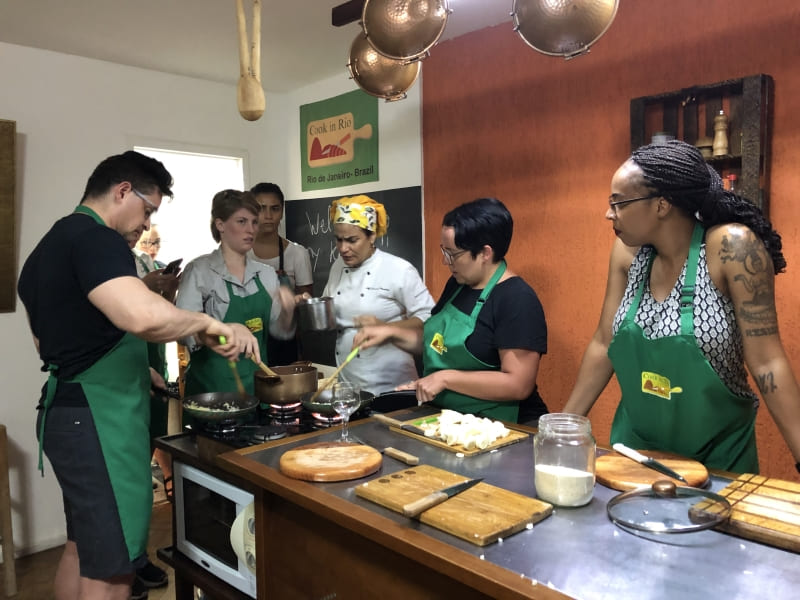
Then, under her supervision, the non-locals prepare the rice to perfection, a lesson that will last for their lives!
Preparing the plantain farofa
Another very famous side dish will complete the main course: plantain farofa. By the way, did you know that there are 28 types of banana in Brazil and picking the right one is essential to make this side dish?
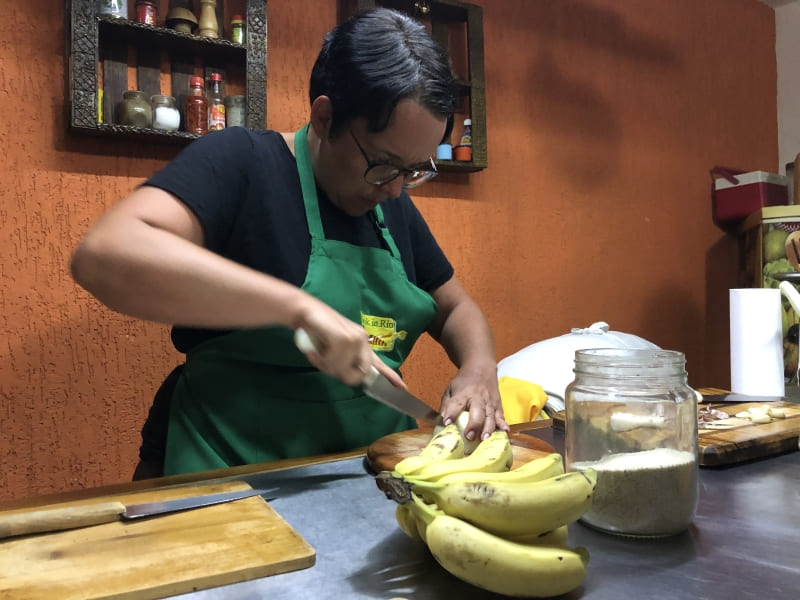
Farofa is very easy and quick to make it. As it is, again, everybody will take part in the preparation. The new friends will start preparing the side dishes, which will be put aside while waiting for the main dish.
The main course
Before starting the preparation of the main course, Chef Simone offers everybody a chance to make another version of caipifruta. This time, pineapple will be added to the regular version.
Some minutes later, and happier than ever, it’s time to face the ultimate challenge: prepare the authentic moqueca baiana!
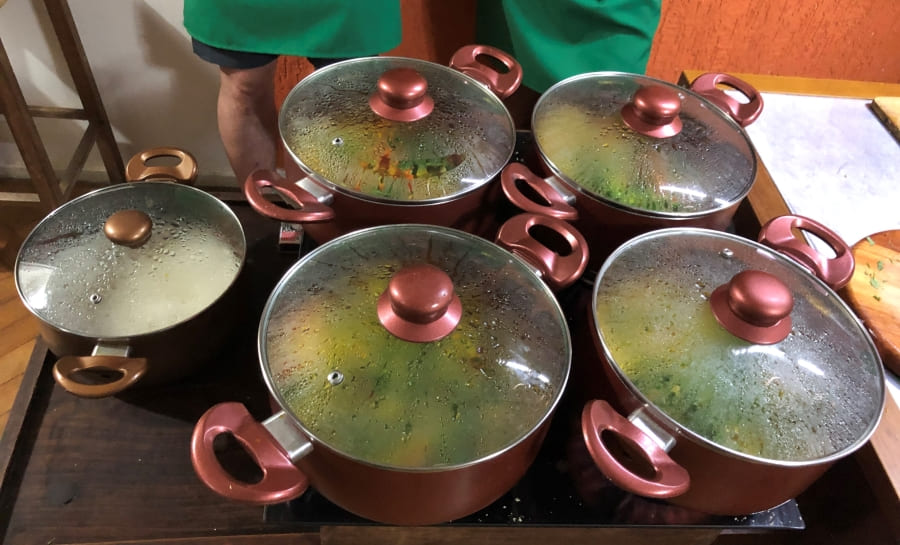
Chef Simone then explains that there is a limit of ten minutes to marinate the fish. Otherwise, instead of becoming really tasty, it’s transformed into a ceviche.
Needles to say, the main course is the one which requires more time to be prepared. It’s not a problem to wait because probably nobody is starving (the appetizers are plenty enough) and everybody feels comfortable with the others. Chef Simone has such a strong and vibrant personality that facilitates the integration of the newcomers.
The dinner
When dinner is ready, everybody seats around a big table and shares the delicious meal full of joy, knowing that each is savoring not only an impeccable meal but is also toasting the magic of diving deep into the local culture.
And if you think it’s completely done, you are wrong. Chef Simone surprises once again! Each of us receives a paçoca de rolha (a small peanut Brazilian candy in the shape of a cork) as a dessert and a farewell souvenir: a bag with a mix of cumin and black pepper. A memory from the marvelous experience each one will take home.

Cook in Rio: what you need to know before booking
Well, first of all, the majority of the lessons are in English as the experience is developed to show the Brazilian cuisine to foreigners. However, everybody is welcome. Besides, Chef Simone speaks Spanish and Portuguese, so nobody will feel neglected.
Of course that sharing the same language will be an advantage as it will make socialization easier.
Special arrangements can also be done. Tailor-made lessons can be prepared in order to accommodate groups of family and friends, for example.
You can book your experience throughout Get Your Guide website (partner of this blog) or directly on Cook in Rio website.
Practical Information
- Address: Rua Belfort Roxo, 161 2nd floor/ Copacabana
- Phone: +55 21 98894-9857
- Contact: info@cookinrio.com
My experience at Cook in Rio
As a Brazilian, I’d already prepared moqueca many times before this class. However, preparing it among people from different nationalities (Finish, Canadians, Americans and Germans) was a great opportunity to share and learn.
Moreover, it was a chance to show the non-locals the Brazilian hospitality as besides Chef Simone and I, there were also two more Brazilians in the group and we all mingled wonderfully with the “gringos”. We also had a chance to say to them that this word, that may sound a little pejorative to some, is a sweet nickname we usually give to them. After all, we love gringos!
Acknowledgement
I took part at Cook in Rio experience by invitation. However, all the impressions and opinions reflect my genuine experience.
References
https://www.jamieoliver.com/recipes/fish-recipes/moqueca-baiana/
https://www.allrecipes.com/recipe/221446/moqueca-baiana-brazilian-seafood-stew/
http://uxua.com/en/trancoso/cuisine/taste-of-tradition-moqueca-baiana
https://en.wikipedia.org/wiki/Moqueca
https://pt.wikipedia.org/wiki/Moqueca
Extras
You might be interested in Klecia’s point of view about the experience:
https://www.fuiserviajante.com/rio-de-janeiro/cook-in-rio/
Some other posts about Rio de Janeiro, perhaps? You can find other interesting articles here at Turista FullTime, among them:
- Things to do in Copacabana
- A visit to Christ the Redeemer
- Top things to do in Ipanema
- The Botanical Garden of Rio de Janeiro











4 Responses
otima e completa cobertura do Cook in Rio! obrigado, Regina Oki, por dedicar tanta atencao aos varios detalhes que fomos aperfeicoando ao longo de (agora em setembro) 10 anos!
Ola, Cristiano! Muito obrigada, fico muito feliz que vocês tenham gostado. Foi uma experiência deliciosa! Parabéns pelo ótimo trabalho de vocês!
It was a delicious experience! I learned so much with Chef Simone, I will try some of the dishes at home, for sure!
Hi, Klécia! Thank you so much for your participation! Indeed, it was an experience everybody should try. I had a great time with Chef Simone and her guests. All the best,
Regina